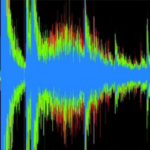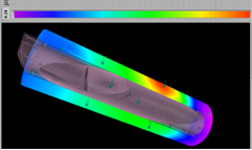Breakthroughs in magnet performance, particularly in training and operating margin requirements, will require further understanding and control of the underlying physics mechanisms. Energy deposition that initiates quenches, resulting in training or sub-par magnet performance, can emanate from a variety of sources, resulting in a “disturbance spectrum.” Well-defined experiments designed to identify and “fingerprint” the sources, and to evaluate technology alternatives that minimize the amplitude of such disturbances, are critical to addressing the goals of the program. This magnet science component of the program leverages developments in modeling, materials, and diagnostics that are critical to advancing magnet technology and serve as a core element of the MDP.
 |
Examples of the foundational R&D that we perform include a study of the acoustic signature of quenches (left) and related measurement of how mechanical disturbances propagate through a magnet (right). Understanding the nature, management, and if possible prevention of quenches — sudden losses of superconductivity that propagate rapidly through the magnet and take it offline — is one of the key topics in our field. So is the related matter of reducing “training,” a stepwise break-in process for reaching a magnet’s design field strength. More… |
 |
||
We are pursuing a broad technology development program designed to focus on specific topics related to the Driving Questions. Technology development and training studies use subscale model magnets that serve as rapid, cost-effective turnaround testbeds for exploitation of improvements in materials and diagnostic techniques. To develop new capabilities, we will integrate test groups at participating institutions for efficiency, increasing intellectual critical mass, improving capabilities and providing adequate accessibility. Investigation of new materials (insulation, impregnation and structural materials, etc.) is another crucial part of our efforts to improve training behavior; these matters can be explored with low-cost, dedicated laboratory experiments prior to testing in subscale magnets, and are ideal for collaboration with universities and industry. Further development of analysis tools, quench detection and protection techniques, and diagnostics is a final key set of endeavors.
To Learn More…
Click here to get detailed information on these topics, view a chart of schedules and milestones, and meet the management team for this program element.
